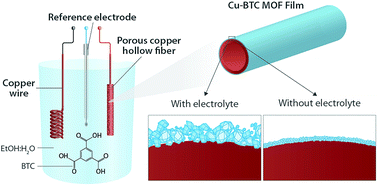Electroforming of a metal–organic framework on porous copper hollow fibers†
Abstract
Porous copper hollow fibers have been used, for the first time, as both a support structure and a metal source for preparing thin metal–organic framework (Cu-BTC) films via a fast, facile and direct electrochemical route. The focus is on the effects of the presence of a supporting electrolyte and the magnitude of the applied electrical potential on the formation and the morphology of the films. In the absence of a supporting electrolyte, and at low potential, more uniform films with smaller particles are obtained. This is attributed to the more pronounced electric-field driven mass transport of the organic ligand from the liquid bulk towards the surface of the electrode combined with the slower dissolution of copper due to the lower overpotentials. In the presence of a supporting electrolyte the ligand transport is much slower and copper dissolution is higher due to higher overpotentials; this results in the formation of less homogeneous films and the growth of metal–organic framework crystals in the liquid bulk. The localized formation of thin metal–organic framework films on metal porous hollow fibers with high surface area to volume ratio is an important step towards various applications, including membranes, microfluidic devices, sensors and heterogeneous catalysts.



 Please wait while we load your content...
Please wait while we load your content...